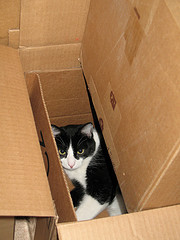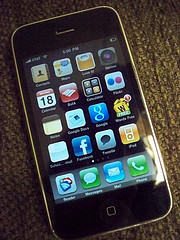|
|
|
Wednesday, November 6th, 2013

Every so often I come across an old post that is to strong and relevant I feel the need to repost it as opposed to just sharing a link.
Why ‘Cracked Pots’ are Good For Your Team is such a post.
Do you have the courage to hire people with quirks? Those who are unconventional or have unconventional experience for the position? Will you hire someone who is flawed in some way?
Would you hire a ‘cracked pot’ for your team?
An elderly Chinese woman had two large pots, each hung on the ends of a pole which she carried across her neck.
One of the pots had a crack in it while the other pot was perfect and always delivered a full portion of water.
At the end of the long walks from the stream to the house, the cracked pot arrived only half full.
For a full two years this went on daily, with the woman bringing home only one and a half pots of water.
Of course, the perfect pot was proud of its accomplishments.
But the poor cracked pot was ashamed of its own imperfection, and miserable that it could only do half of what it had been made to do.
After two years of what it perceived to be bitter failure, it spoke to the woman one day by the stream.
“I am ashamed of myself, because this crack in my side causes water to leak out all the way back to your house”‘
The old woman smiled, “Did you notice that there are flowers on your side of the path, but not on the other pot’s side?”
“That’s because I have always known about your flaw, so I planted flower seeds on your side of the path, and every day while we walk back, you water them.
For two years I have been able to pick these beautiful flowers to decorate the table.
Without you being just the way you are, there would not be this beauty to grace the house.”
Managed correctly, appreciated instead of tolerated or, worse, homogenized, the idiosyncrasies of your team, the unusual backgrounds, your cracked pots, are what push productivity, juice creativity and drive innovation across the board.
And often it’s another’s management failure that gives you the opportunity to increase the strength of your team.
So cherish the pots you already have and never hesitate to hire another.
Flickr image credit: Blind Grasshopper
Posted in Business info | 2 Comments »
Tuesday, October 22nd, 2013

According to brothers Tom and David Kelley, founders of the iconic design firm IDEO, everybody is creative no matter what their background or career path.
“…early failures, defeats and setbacks can lead otherwise creative people to shut down their own best ideas.”
If you accept their reasoning and your team isn’t as creative as you would like the fault most likely lies with you.
The “early” in the above quote can refer to early in life, but also early in tenure.
How often have you hired someone with a track record of creativity only to find them carefully coloring within the lines?
That’s usually the result of having creative ideas rejected, arbitrarily shot down or, worse, ridiculed—not once, but over and over.
Even when those negative responses are from a team member, it’s still your responsibility, since the culture that makes acts like that acceptable is either sourced from or condoned by you.
Flickr image credit: liz west
Posted in Business info | No Comments »
Tuesday, October 15th, 2013
 Just as a company’s culture reflects its values, its advertising typically reflects its culture. Just as a company’s culture reflects its values, its advertising typically reflects its culture.
Most ads are relatively generic, cars, food, even drugs; with minor changes to the words or voiceover you can interchange competing products almost unnoticeably.
Most companies prefer to play it safe, whether in advertising or culture, sticking with the idea that “if it works for them it will work for us.” Call it the no/low risk approach.
Back when Apple’s culture was cutting-edge, so were its ads—remember the ad introducing the Mac? It was shown only once during the 1984 Super Bowl, but is remembered 30 years later.
A far cry from the safe, generic iPhone ads of today, which are quickly forgotten.
According to a new ad from Guinness, “The choices we make reveal the true nature of our character.”
A great mantra and absolutely true—for individuals and corporations.
Guinness’ new ad chose to go against every cultural norm found in beer advertising.
Did it work?
Flickr credit: recoverling; YouTube credit: Guinness
Posted in Culture, Ducks In A Row | No Comments »
Thursday, October 10th, 2013
 Everybody has a box. Everybody has a box.
And no matter how hard you try you’ll never really think outside it.
But you don’t have to.
As with most things, the good and bad of boxes rests with how you view them.
It’s not the box that matters, but its size and how you address that.
Steven Spielberg’s box is immense, far larger than most, yet he is constantly enlarging it, as did Steve Jobs.
And therein lays one of the secrets of a creative organization.
It’s not about encouraging your people to “think outside the box,” it’s about helping each to understand his/her own box and how to enlarge it.
Because that’s how it works.
As soon as you step outside your box, a new one forms. Once you totally use up its content and find its sides you go outside that box, a new one forms and the process begins again.
It takes work, but the process can continue throughout life—although some never start and some get comfortable in a certain box and retain it.
There will always be a box, but with effort it can be enlarged enough to encompass galaxies—and even entire universes.
Sharing this knowledge with your team and providing a culture in which they are encouraged and helped to expand their box is the hallmark of a great founder.
Flickr image credit: Mr. T in DC
Posted in Culture, Innovation, Personal Growth | No Comments »
Monday, October 7th, 2013

Are you looking for an edge when interviewing, whether as boss or candidate?
Do you see benefit from strengthening your so-called EQ?
What if all it took was the willingness to read?
[The study] found that after reading literary fiction, as opposed to popular fiction or serious nonfiction, people performed better on tests measuring empathy, social perception and emotional intelligence — skills that come in especially handy when you are trying to read someone’s body language or gauge what they might be thinking.
What is ‘literary fiction’? How does it differ from popular fiction or non-fiction stories, like biographies?
In literary fiction, like Dostoyevsky, “there is no single, overarching authorial voice,” he said. “Each character presents a different version of reality, and they aren’t necessarily reliable. You have to participate as a reader in this dialectic, which is really something you have to do in real life.”
Apparently, just as boredom is an excellent source of creativity, engaging with characters who have no obvious, predetermined course and are struggling in a plot that could go many different ways sensitizes you to the subtleties in their thoughts and actions and opens your mind to a myriad of possibilities.
The Lady and the Tiger, a short story by Frank R. Stockton, is a good example of characters, story and, in this case, an ending that guarantees deep thinking and lively discussion.
Reading is good brain exercise and choosing to read something with a great story that also gives you a decided edge in both your business and personal life is called a no-brainer.
Flickr image credit: romana klee
Posted in Communication, Personal Growth | No Comments »
Wednesday, October 2nd, 2013

For many LIFE has become life, which they choose to live out on a small screen instead of on nature’s infinite stage.
But for some, that small, smooth screen is becoming an onramp to the infinite stage.
Smartphones and tablets, with their flat glass touch screens and nary a texture anywhere, may not seem like the best technological innovation for people who cannot see. But advocates for the blind say the devices could be the biggest assistive aid to come along since Braille was invented in the 1820s.
Not surprisingly, the iPhone is a leader in assistive apps.
One such is VoiceOver, which reads aloud the name of each app as you run your finger over it, just as a visual label shows when you rollover a menu item.
Many developers either don’t think or can’t be bothered to take advantage of the technology by labeling the buttons on their app, which leaves sight-challenged users literally in the dark.
What those developers haven’t figured out is that this is a substantial market—ten million in the US alone and a globally aging population that guarantees it will grow.
Moreover, it’s a highly networked market where anything new and useful is speedily shared.
Even if you are strictly in it for the money enabling your app to take advantage of the assistive technologies built into iOS and Android is smart, since doing so can differentiate you from the pack and help you access valuable media attention.
Writing an app seems to be a right of passage these days even among non-techies for whom it is a hobby and not a job.
So why not write it for a built-in, accessible market and do a bit of good along with the added income?
Flickr image credit: Bonnie Brown
Posted in Entrepreneurs, Innovation | No Comments »
Monday, September 23rd, 2013

An article a few days ago made me a happy camper for three very different reasons. Here they are in the order of their importance to me.
Reason 1: It provided a scientifically acceptable reason for having a messy desk and gave me permission to quit trying to clean it up. This was especially nice, since ‘clear desk’ is a constant item on my to-do list.
Reason 2: The clinically tested reason for having a perennially messy desk is creativity. How cool is that?
Reason 3: I beat the pattern because I have creativity, yet I eat healthy and go to the gym daily (not on weekends).
Essentially, the study showed that “Those in messy spaces generated ideas that were significantly more creative, according to two independent judges,… people that are organized and predictable, typically eat better and live longer than people who are disorderly. They also tend to have immaculate offices.
Last year I found that I possessed three of the five parts of Innovator DNA, based on a Harvard definition, but, after a lifetime of trying, am totally incapable of the final two.
Dr. Kathleen D. Vohs, a behavioral scientist at the University of Minnesota and the leader of the study, seems to think that the only way a messy desk person could develop healthy habits is to clean up their desk.
“My advice would be, if you need to think outside the box” for a future project, says, then let the clutter rise and unfetter your imagination. But if your primary goal is to eat well or to go to the gym, pick up around your office first. By doing this, the naturally messy can acquire some of the discipline of the conscientious.
I’m willing to bet that Dr. Vohs is a clean desk person or she would understand that it’s not that simple.
But, as a messy desk person, I will tell you that you can build a healthy eating-gym attending persona without ever cleaning up your desk.
One caveat, in part of the study people were given a choice between chocolate and a healthy snack (carrot sticks?). The messy desk crowd took the chocolate, which meant a messy desk equals unhealthy choices.
However, based on a lifetime of experience with neat desk friends, all with lots of self-discipline, I think it just means they didn’t like chocolate.
Flickr image credit: Jeffrey Beall
Posted in Innovation, Motivation, Personal Growth | No Comments »
Wednesday, September 18th, 2013
 When I lived in San Francisco I always found it a point of hilarity that the those in tech assumed that everybody everywhere were as tech-centric as they were and I know from friends that that attitude hasn’t changed. When I lived in San Francisco I always found it a point of hilarity that the those in tech assumed that everybody everywhere were as tech-centric as they were and I know from friends that that attitude hasn’t changed.
It was/is also a given that innovation is hottest in the Bay Area/Silicon Valley closely followed by places like Silicon Alley in New York City and similar areas around the world.
And the greatest myth of all is that innovation is hottest in startups; especially those started in a college dorm.
Large public companies must innovate or lose the faith of their investors and the tech-centric world always points with pride to giants like Google, Apple and Amazon as innovation leaders.
But are they?
Not according to Hal Gregersen, Senior Affiliate Professor of Leadership and Innovation at INSEAD, and Jeff Dyer, Professor of Strategy at Brigham Young University, co-authors (with Clayton Christensen at Harvard Business School) of the bestseller The Innovator’s DNA.
To compile the list, we use what we call the “Innovation Premium,” which is calculated by:
- Projecting a company’s income as expressed in cash flows from existing businesses;
- Determining anticipated growth from those businesses;
- Comparing the net present value (NPV) of those cash flows with the firm’s current market capitalisation.
We require at least seven years of financial data – a feature that for the moment excludes companies such as Facebook Inc. – and only consider firms with a market value greater than $10 billion. We also use a “research and development” screen, which requires qualified companies to make some investment in R&D.
Using those criteria to compile a list of the 100 Most Innovative Companies, Google is number 47, while Apple is in 79th place, both well below number 30 P&G; Amazon is number seven and Salesforce.com is first for the third year in a row.
Facebook hasn’t been around long enough to qualify and there’s no telling if it will be.
Our list illustrates investors’ appreciation of these companies’ potential as innovators for the long term.
That’s the same reason VCs and angels invest in startups for the short term.
Image credit: Insead
Posted in Innovation | No Comments »
Tuesday, September 17th, 2013

Discussion on company culture usually center on what a company does with regards to its people focusing primarily on perks and attitudes.
There’s recognition that in addition to the corporate culture there are dozens of subcultures, since every manager, no matter what level, shapes/tweaks the culture for her subordinates.
If managers want to hire successfully they need to understand that culture is a direct result of MAP (mindset, attitude, philosophy™) and no two people’s MAP is identical.
Simply put, culture is the ‘what’, while MAP is the ‘why’.
It’s relatively easy to know the ‘whats’ of your culture.
Understanding the ‘why’ takes more effort.
But if you don’t understand your MAP, the ‘why’ of your and your company’s actions, there is every chance that you’ll have great difficulty implementing the kind of culture that’s attracts and retains great talent.
That’s because the ‘what’ needs to be, at the very least, synergistic with the ‘why’, whether it’s your MAP or the candidates, otherwise performance and creativity will suffer.
Knowing your MAP is like knowing what size clothes you wear—it keeps you from hiring people who would have little chance to succeed in the environment you provide.
Flickr image credit: lennox_mcdough
Posted in Culture, Ducks In A Row | No Comments »
Thursday, August 29th, 2013
 I read about a lot of startups, but the ones that really resonate with me are the ones that are doing more than creating a business. I read about a lot of startups, but the ones that really resonate with me are the ones that are doing more than creating a business.
I can’t write them all up, so I though I’d give you the links to a few favorites along with my reasons.
For Israel and Palestine, entrepreneurial passion may do what so-called diplomacy has failed to do.
Even by Middle East standards, the scene in a Dead Sea restaurant, situated within a “green zone”–a no-man’s-land claimed by neither Israelis nor Palestinians–was surreal.
What do you get when you combine an Israeli Special Forces commando, an Arab investor and a religious Zionist? An ultra hot startup called Webydo.
Webydo has removed software code developers and programmers from the picture – enabling professional graphic designers to create sites on the fly for ten times cheaper, and far faster.
I am a dedicated recycler, so you can imagine my feelings when my grocer stopped taking plastic bags for recycling. When I asked why he said that China wasn’t accepting them for recycling, so there was no place to send them. Terrific! We use all that energy to send them to China, so they can ship back whatever they made from them.
I much prefer a solution being developed by Sierra Energy called the FastOx Pathfinder.
The centerpiece, a waste gasifier that’s about the size of a shower stall, is essentially a modified blast furnace. A chemical reaction inside the gasifier heats any kind of trash — whether banana peels, used syringes, old iPods, even raw sewage — to extreme temperatures without combustion. The output includes hydrogen and carbon monoxide, … can be burned to generate electricity or made into ethanol or diesel fuel.
As you can see, the apps that entrepreneurs and investors seem to love aren’t on my interest list; they mostly solve the imagined problems of “affluent and hyper-connected 20-somethings in cities with great cell service and ample Wi-Fi” who prefer impersonal sex-without-strings, bargains and inane pastimes.
But there’s finally an app a parent can truly love—especially when separated from their children in a war-torn country—from an entrepreneur who had the sense to avoid the bleeding edge.
According to UNICEF, RapidFTR’s ability to photograph, record and share information about lost children has reduced the time it takes to reunite families from over six weeks to just hours. The app was not particularly complicated, from a technical standpoint, but Mr. Just wanted to make sure it was something aid organizations would actually adopt.
Personal annoyance, in this case with charging wires, has always been an innovation driver, but stubbornness and a silo-breaking mentality also help. And even after all that, Meredith Perry still had a difficult time getting uBeam funded—well, of course SHE did.
Her idea, she discovered, meant marrying the fields of sound, electricity, battery technology and other subspecialties. (…) Each expert seemed to dwell in his own private silo, so that whenever she crossed from one discipline to another, she would run into the same wall of constricted thinking.
Finally, on a lighter note, another woman is out to abolish the need for the underwire that provides all that lift that women tolerate and men crave.
In this case, 3-D has nothing to do with 3-D fabric printing, but rather with the way the Curvessence technology used in the brand’s lingerie works. Cohen says the nylon polymers sculpt to conform to a woman’s torso, and “remembers” its shape over time, slowly returning to its original form if it is temporarily stretched, for instance.
Flickr image credit: Seth Waite
Posted in Innovation | No Comments »
|
 Subscribe to
Subscribe to
MAPping Company Success
About Miki 
Clarify your exec summary, website, etc.
Have a quick question or just want to chat? Feel free to write or call me at 360.335.8054
The 12 Ingredients of a Fillable Req
CheatSheet for InterviewERS
CheatSheet for InterviewEEs™
Give your mind a rest. Here are 4 quick ways to get rid of kinks, break a logjam or juice your creativity!
Creative mousing
Bubblewrap!
Animal innovation
Brain teaser
The latest disaster is here at home; donate to the East Coast recovery efforts now!
Text REDCROSS to 90999 to make a $10 donation or call 00.733.2767. $10 really really does make a difference and you'll never miss it.
And always donate what you can whenever you can
The following accept cash and in-kind donations: Doctors Without Borders, UNICEF, Red Cross, World Food Program, Save the Children
*/
?>About Miki
About KG
Clarify your exec summary, website, marketing collateral, etc.
Have a question or just want to chat @ no cost? Feel free to write
Download useful assistance now.
Entrepreneurs face difficulties that are hard for most people to imagine, let alone understand. You can find anonymous help and connections that do understand at 7 cups of tea.
Crises never end.
$10 really does make a difference and you’ll never miss it,
while $10 a month has exponential power.
Always donate what you can whenever you can.
The following accept cash and in-kind donations:
|






 Just as a company’s culture reflects its values, its advertising typically reflects its culture.
Just as a company’s culture reflects its values, its advertising typically reflects its culture. Everybody has a box.
Everybody has a box.




 I read about a lot of startups, but the ones that really resonate with me are the ones that are doing more than creating a business.
I read about a lot of startups, but the ones that really resonate with me are the ones that are doing more than creating a business.
